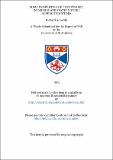Some properties of the dynamic intermediate state in type 1 superconductors
Abstract
The high resolution magneto-optic method using the Faraday effect in thin films of EuS:EuF₂has been used to observe the dynamic intermediate state induced by the passage of an electric current or a heat current through thin slabs of the superconductors Pb, In and Sn. The ease with which the various intermediate state topologies could be made to move has been studied and several features of the interaction of moving flux with pinning sites have been noted. In the case of the current induced motion the measured characteristics of flux flow velocity versus current have been found to exhibit two distinct regions. Firstly, a linear region where the observed velocity was found to agree reasonably well with the predictions of the recent general theory of Andreev and Dzhikaev when allowance was made for the effects of pinning by the introduction of a velocity independent pinning force. Secondly, a curved region was found for currents close to the critical current J₀ in agreement with earlier work using other methods of observation. Possible reasons for the existence of this curvature were examined in detail, and. it was found, that a phenomenological model based, on the presence of a Gaussian distribution of critical current values throughout the sample could account satisfactorily for the observations. The presence of such a Gaussian distribution was confirmed by observing the variations in distance travelled by a domain subjected, to a pulsed, driving current. The curvature was found in disagreement with the theory of thermal activation and. no evidence could be found, for the presence of a velocity dependent pinning force. In the case of the thermally induced, motion which was investigated only in Pb, it was found, in agreement with the very recent work of Laeng and Rinderer, that there exist two competing mechanisms driving the flux. The first of these, that treated, by Andreev and Dzhikaev in their general theory, which acts in a direction parallel to the heat flow, was found to be effective at low temperatures (T ≪ 4.2K) but to be negligible at high temperatures. The magnitude of the velocity produced by this mechanism agreed reasonably well with the theory at low temperatures but was in complete disagreement at high temperatures when the theory predicts that it should still be observable. The second mechanism which acts perpendicularly to the heat flow dominated the motion at high temperatures but its magnitude did not agree with the predictions of the recent theory of Rothen, which ascribes the effect to the thermoelectric power of the normal state. It should be noted that to overcome the pinning all of the low temperature observations (T ≪ 4.2k) were performed in the presence of an electric current. Clearly, much more work requires to be done to clarify these observations.
Type
Thesis, PhD Doctor of Philosophy
Collections
Items in the St Andrews Research Repository are protected by copyright, with all rights reserved, unless otherwise indicated.

